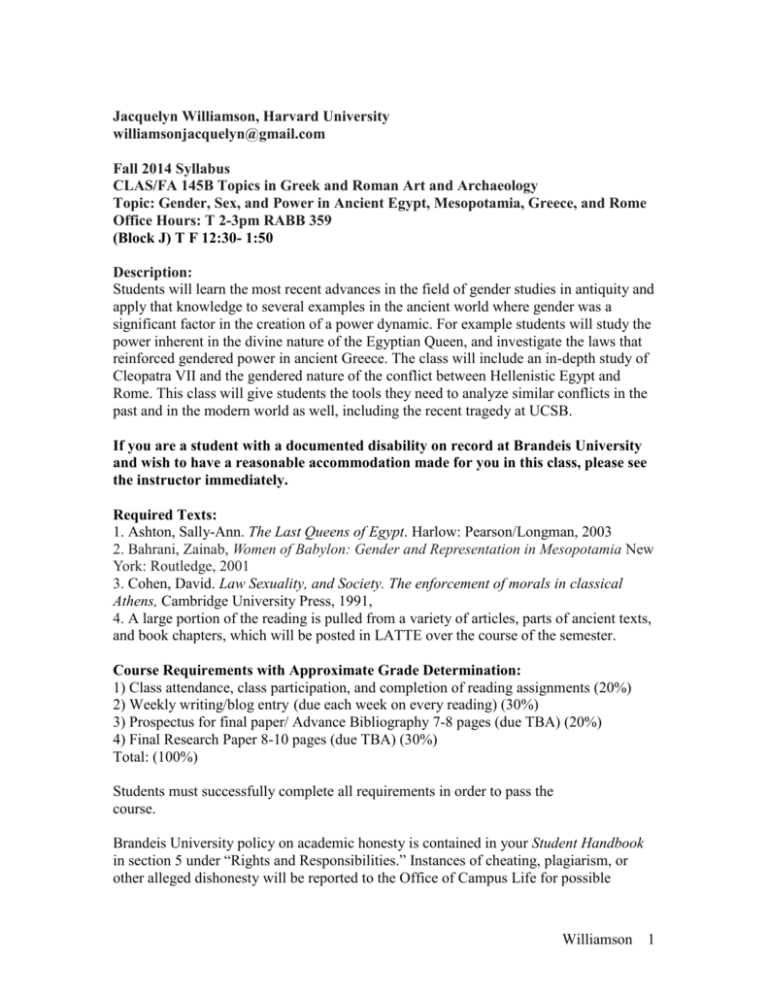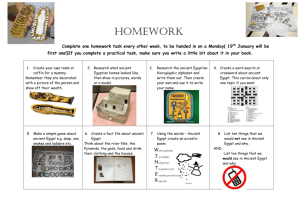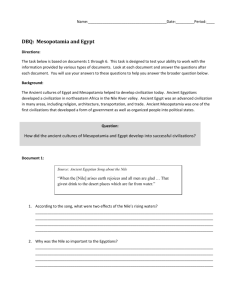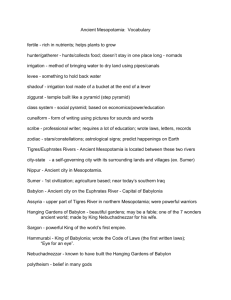
Jacquelyn Williamson, Harvard University
williamsonjacquelyn@gmail.com
Fall 2014 Syllabus
CLAS/FA 145B Topics in Greek and Roman Art and Archaeology
Topic: Gender, Sex, and Power in Ancient Egypt, Mesopotamia, Greece, and Rome
Office Hours: T 2-3pm RABB 359
(Block J) T F 12:30- 1:50
Description:
Students will learn the most recent advances in the field of gender studies in antiquity and
apply that knowledge to several examples in the ancient world where gender was a
significant factor in the creation of a power dynamic. For example students will study the
power inherent in the divine nature of the Egyptian Queen, and investigate the laws that
reinforced gendered power in ancient Greece. The class will include an in-depth study of
Cleopatra VII and the gendered nature of the conflict between Hellenistic Egypt and
Rome. This class will give students the tools they need to analyze similar conflicts in the
past and in the modern world as well, including the recent tragedy at UCSB.
If you are a student with a documented disability on record at Brandeis University
and wish to have a reasonable accommodation made for you in this class, please see
the instructor immediately.
Required Texts:
1. Ashton, Sally-Ann. The Last Queens of Egypt. Harlow: Pearson/Longman, 2003
2. Bahrani, Zainab, Women of Babylon: Gender and Representation in Mesopotamia New
York: Routledge, 2001
3. Cohen, David. Law Sexuality, and Society. The enforcement of morals in classical
Athens, Cambridge University Press, 1991,
4. A large portion of the reading is pulled from a variety of articles, parts of ancient texts,
and book chapters, which will be posted in LATTE over the course of the semester.
Course Requirements with Approximate Grade Determination:
1) Class attendance, class participation, and completion of reading assignments (20%)
2) Weekly writing/blog entry (due each week on every reading) (30%)
3) Prospectus for final paper/ Advance Bibliography 7-8 pages (due TBA) (20%)
4) Final Research Paper 8-10 pages (due TBA) (30%)
Total: (100%)
Students must successfully complete all requirements in order to pass the
course.
Brandeis University policy on academic honesty is contained in your Student Handbook
in section 5 under “Rights and Responsibilities.” Instances of cheating, plagiarism, or
other alleged dishonesty will be reported to the Office of Campus Life for possible
Williamson 1
referral to the Student Judicial System. The adjudication process is also outlined in your
Handbook. Potential consequences of academic dishonesty include (in addition to an “E”
on the assignment) failure in the course, disciplinary probation, and suspension from the
University. A record of any offense will remain in a student’s disciplinary file in the
Office of Student Affairs throughout his or her career at Brandeis.
Blog assignment:
This is a writing intensive class. Each week, every student will submit a one page Word
document length page response paper to the readings (using double spaces,12 point
Times New Roman Font, and the preset Word margins.) Students will be invited to enroll
in the blog during the second full week of classes. Until that time, they will submit the
page responses in class, printed out. The page may contain: 1. a summary of the reading,
including the main deductions and evidence of the author, 2. a short opinion or personal
response to the reading with other relevant observations. The objective of this assignment
is to increase critical thinking as well as critical writing skills; the more you write, the
better you write.
The title/address of the blog:
Title: Brandeis Gender and Power Blog
Address: http://brandeisgenderandpower.blogspot.com/
Weekly Topics and Required Readings:
Aug. 29
Class 1: Introduction to syllabus and course, Introduction Lecture: The Epic
of Gilgamesh and the agency of women and sex in the ancient world
Week 2 September 2nd, 5th
Class 2: The impact of feminist scholarship on ancient studies. Bahrani,
Zainab, Women of Babylon: Gender and Representation in Mesopotamia New
York: Routledge, 2001, pg 1-27.
Class 3: Problem of Categories. Joyce, Rosemary 2008 Ancient Bodies, Ancient
Lives, Sex, Gender, and Archaeology, New York: Thames and Hudson.
“Goddesses, matriarchs, and manly-hearted women, troubling categorical
approaches to gender,” pg 46-66
Week 3 September 9th, 12th
Class 4: Performativity Theory Reinterpreted. Joyce, Rosemary. “Feminist
Theories of Embodiment and Anthropological Imagination: Making Bodies
Matter.” In Feminist Anthropology, ed. Pamela L. Geller and Miranda Stockett,
43-54. Philadelphia: University of Pennsylvania Press, 2006.
Williamson 2
Class 5: Rethinking gender. Sarah Nelson, Myriam Rosen-Ayalon (eds) 2002 In
Pursuit of Gender Worldwide Archaeological Approaches, Walnut Creek: AltaMira
Press. “Beyond Complementarity and Hierarchy: New Definitions for
Archaeological Gender Relations,” Joan Gero, M. Christina Scattolin, pg. 155-172.
Week 4 September 16th, 19th
Class 6: Relocating ancient women’s power through the modern Islamic
movement. Mahmood, Saba “Feminist Theory, Embodiment, and the Docile
Agent: Some Reflections on the Egyptian Islamic Revival.” Cultural Anthropology
16.2, 2001, pg. 202-236
Class 7: (Em)powered Gender in Mesopotamia. Daniel C. Snell 2007 A
Companion to the Ancient Near East Malden, Blackwell Publishing “Royal
Women and the Exercise of Power in the Ancient Near East,” Sarah Melville, pg.
235-244
Week 5 September 23rd, 26th no class
Week 6 September 30th, October 3rd
Class 8: Mesopotamia: Evidence and other Problems. Sharon James, Sheila
Dillon (eds) 2012 A Companion to Women in the Ancient World Sussex:
Blackwell “Women in Ancient Mesopotamia,” pg 11-25
Class 9: The art of the female nude in Mesopotamia, Greece, and Today.
Bahrani, Zainab, Women of Babylon: Gender and Representation in Mesopotamia
New York: Routledge, 2001, pg. 70-95.
Week 7 October 7th, 10th
Class 10: Mesopotamia and the gendered Orientalist imagination. Bahrani,
Zainab, Women of Babylon pg 161-179
Class 11: Egyptian Women: Relative Equals? Daniel C. Snell 2007 A
Companion to the Ancient Near East Malden: Blackwell Publishing. “Gender
Roles in Ancient Egypt,” Ann Macy Roth pg. 227-235
Week 8 October 14th, 17th
Class 12: Agents of Chaos? Anne K. Capel and Glenn E. Markoe (eds)1996
Mistress of the House, Mistress of Heaven, Women in Ancient Egypt, New York
Hudson Hills Press. “In women good and bad fortune are on earth: Status and
roles of women in Egyptian culture,” Betsy Bryan, pg. 25-46
Class 13: The sacred celebration of sex in ancient Egypt. Depaw, M and Smith,
M 2004 “Visions of Ecstasy. Cultic Revelry before the goddesses Ai/Nehemanit,”
Williamson 3
Res Severa Verum Gaudium. Festschrift für Karl-Theodor Zauzich zum 65.
Geburtstag am 8 Juni 2004, Studia Demotica VI, Leuven-Paris-Dudley, pg. 67-94
Week 9 October 21st, 24th
Class 14: The Egyptian queen as the divine manifestation of sacred sexuality.
Sarah Nelson (ed) 2003 Ancient Queens Archaeological Explorations Walnut
Creek: AltaMira Press. “She for Whom All That Is Said Is Done: The Ancient
Egyptian Queen” Lana Troy, pg 93-116
Class 15: Gender fluidity: Hatshepsut. Catharine H. Roehrig, Renee Dreyfus,
Cathleen A. Keller (eds) Hatshepsut: From Queen to Pharaoh, New York:
Metropolitan Museum of Art. 2005, pg. 87-106.
Week 10 October 28th, 31st
Class 16: Performance of male gender roles in Hatshepsut’s art. Catharine H.
Roehrig, Renee Dreyfus, Cathleen A. Keller (eds) Hatshepsut pg. 267-284.
Class 17: Ancient Greece: gendered power. David Cohen, Law Sexuality, and
Society. The enforcement of morals in classical Athens, Cambridge University
Press, 1991, pg 70-97
Week 11 November 4th, 7th
Class 18 Greek legal hierarchy. David Cohen, Law Sexuality, and Society. pg
133-170
Class 19: Greek Homosexuality and the Law. David Cohen, Law Sexuality, and
Society. Pg. 171-202
Week 12 Cleopatra VII November 11th, 14th
Class 20: Greek women with religious power. Connelly, Joan Breton. Portrait
of a Priestess, Women and Ritual in Ancient Greece. Princeton University Press,
2007, pg. 197-222
Class 21: Egypt and the Ptolemies. Ashton, Sally-Ann. The Last Queens of
Egypt. Harlow: Pearson/Longman, 2003, 17-48
Week 13 Cleopatra VII (continued) November 18th, 21st
Class 22: Hellenistic queens. Ashton, Sally-Ann. The Last Queens of Egypt. 6996
Williamson 4
Class 23: Takacs, Sarolta A. “Cleopatra, Isis, and the Formation of Augustan
Rome.” In Cleopatra: a sphinx revisited edited by Margaret M. Miles. Berkeley:
University of California Press, 2011. 78-95
Week 14: November 25th (No Class : Thanksgiving 28th)
Class 24: Gruen, Erich S. “Cleopatra in Rome: Facts and Fantasies.” In
Cleopatra: a sphinx revisited edited by Margaret M. Miles, Berkeley: University
of California Press, 2011. 37-53.
Class 25 Walker, Susan, and Higgs, Peter. Cleopatra of Egypt: From History to
Myth. London: British Museum Press, 2001 (excerpts TBA)
Week 15: December 2nd, 5th
Class 26: Gurval, Robert A.“Dying Like a Queen: The Story of Cleopatra and the
Asp(s) in Antiquity.” In Cleopatra: a sphinx revisited edited by Margaret M.
Miles, 54-77. Berkeley: University of California Press, 2011.
Class 27 – Class 28: readings TBA
Resources:
In addition to the class readings, content from the lectures will be drawn from the
following resources, which you should also consult for topics for your paper:
Gender:
Asher-Greve, Julia; Joan Goodnick Westenholz (eds)
Goddesses In Context: On Divine Powers, Roles, Relationships and Gender in
Mesopotamian Textual and Visual Sources Academic Press Fribourg.
“Gender Theory and Issues,” 2013, Julia M. Asher-Greve, pg 15-28
Hays-Gilpin, Kelley and David S. Whitley
Reader in Gender Archaeology, London, Routledge.
“Gender Iconography and Ideology, the Palaeoloithic Mother Goddess, Fact or
Fiction?” 1998, pg 257-268
Joyce, Rosemary A.
“Feminist Theories of Embodiment and Anthropological Imagination: Making
Bodies Matter.” In Feminist Anthropology, ed. Pamela L. Geller and Miranda
Stockett, 43-54. Philadelphia: University of Pennsylvania Press, 2006.
Joyce, Rosemary
Ancient Bodies, Ancient Lives, Sex, Gender, and Archaeology, New York: Thames
and Hudson. 2008
Williamson 5
Mahmood, Saba
“Feminist Theory, Embodiment, and the Docile Agent: Some Reflections on the
Egyptian Islamic Revival.” Cultural Anthropology 16.2, 2001, pg. 202-236
Mahmood, Saba
Politics of Piety: The Islamic Revival and the Feminist Subject. Princeton
University Press, 2005.
Nelson, Sarah and Myriam Rosen-Ayalon (eds)
In Pursuit of Gender Worldwide Archaeological Approaches, Walnut Creek:
AltaMira Press. 2002
Nelson, Sarah (ed)
Ancient Queens Archaeological Explorations Walnut Creek: AltaMira Press.
“Ancient Queens: an introduction” 2003, Sarah Nelson, pg. 1-18; “She for Whom
All That Is Said Is Done: The Ancient Egyptian Queen” Lana
Troy, pg 93-116
Topics:
Augustus.
The Deeds of the Divine Augustus. In www.classics.mit.edu translated by Thomas
Bushnell, 1998.
Bottéro, Jean.
Religion in Ancient Mesopotamia transl. Teresa Lavender Fagan, Chicago:
Chicago University Press, 2001.
Cooper, Jerrold.
“Genre, Gender, and the Sumerian Lamentation” Journal of Cuneiform Studies,
Vol 58, 2006, pg 39-47.
Dever, William G.
Did God Have a Wife? Archaeology and Folk Religion in Ancient Israel,
Michigan: Wm. B Eerdmans Publishing Co. 2005
Everitt, Anthony.
The Rise of Rome. New York: Random House, 2012.
Frood, Elizabeth.
“Sensuous Experience, Performance, and Presence in Third Intermediate Period
Biography” in Ancient Egyptian Literature Theory and Practice, Roland
Enmarch, Verena Lepper (eds), Oxford: Oxford University Press. 2013
Holbl, Gunther.
Williamson 6
A History of the Ptolemaic Empire. New York: Routledge, 2001.
James, Sharon and Sheila Dillon (eds)
A Companion to Women in the Ancient World, Sussex: Blackwell. 2012
Jones, Prudence J.
Cleopatra: a sourcebook. Norman: University of Oklahoma Press, 2006
Koloski-Ostrow, Ann Olga; Claire Lyons (eds)
Naked Truths, Women, Sexuality, and Gender in Classical Art and Archaeology.
Routledge Press, London, 2000
Macgregor, Sherry Lou.
Beyond Hearth and Home: Women in the public sphere in Neo-Assyrian society
Helsinki: The Neo-Assyrian Text Corpus Project. 2012
Meyers, Carol.
Rediscovering Eve, Ancient Israelite Women in Context, Oxford: Oxford
University Press. 2013.
Landgráfová, Renata and Hana Navrátilova.
Sex and the Golden Goddess I, Prague: Czech Institute of Egyptology. 2009.
Moyer, Ian S.
Egypt and the Limits of Hellenism. New York: Cambridge University
Press, 2011.
Plutarch.
The Parallel Lives: Life of Antony. In www.penelope.uchicago.edu. Loeb
Classical Library edition, 1920.
Schiff, Stacy.
Cleopatra: a life. New York: Little, Brown and Co., 2010.
Shafer, Byron (ed).
Religion in Ancient Egypt: Gods, Myths, and Personal Practice Cornell
University Press. 1991.
Snell, Daniel C.
A Companion to the Ancient Near East Malden: Blackwell Publishing. 2007
Stavrakopoulou, Francesca and John Barton (eds)
Religious Diversity in Ancient Israel and Judah London: T&T Clark International.
2010
Stökl, Jonathan and Corrine L. Carvalho (eds)
Williamson 7
Prophets Male and Female: Gender and Prophecy in the Hebrew Bible, the
Eastern Mediterranean, and the Ancient Near East Atlanta: Society of Biblical
Literature. 2013.
Williamson 8









